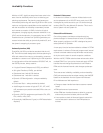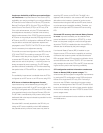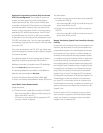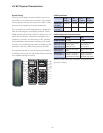join the two server CTN. Previously, if both the Preferred
Time Server (PTS) and the Backup Time Server (BTS)
experienced a simultaneous power outage (site failure),
or both experienced a POR, reinitialization of time, and
special roles (PTS, BTS, and CTS) was required. With this
enhancement, you will no longer need to reinitialize the
time or reassign the roles for these events.
Preview - Improved STP System Management with
new z/OS Messaging: This is a new function planned to
generate z/OS messages when various hardware events
that affect the External Time Sources (ETS) confi gured for
an STP-only CTN occur. This may improve problem deter-
mination and correction times. Previously, the messages
were generated only on the Hardware Management Con-
sole (HMC).
The ability to generate z/OS messages will be supported
on IBM System z10 and System z9 servers with z/OS 1.11
(with enabling support rolled back to z/OS 1.9) in the
second half of 2009.
The following Server Time Protocol (STP) enhancements
are available on the z10 EC, z10 BC, z9 EC, and z10 BC.
The prerequisites are that you install STP feature and that
the latest MCLs are installed for the applicable driver.
NTP client support: This enhancement addresses the
requirements of customers who need to provide the same
accurate time across heterogeneous platforms in an enter-
prise.
The STP design has been enhanced to include support
for a Simple Network Time Protocol (SNTP) client on the
Support Element. By confi guring an NTP server as the
STP External Time Source (ETS), the time of an STP-only
Coordinated Timing Network (CTN) can track to the time
provided by the NTP server, and maintain a time accuracy
of 100 milliseconds.
Note: NTP client support has been available since October
2007.
Enhanced accuracy to an External Time Source: The
time accuracy of an STP-only CTN has been improved by
adding the capability to confi gure an NTP server that has
a pulse per second (PPS) output signal as the ETS device.
This type of ETS device is available worldwide from sev-
eral vendors that provide network timing solutions.
STP has been designed to track to the highly stable,
accurate PPS signal from the NTP server, and maintain
an accuracy of 10 microseconds as measured at the PPS
input of the System z server. A number of variables such
as accuracy of the NTP server to its time source (GPS,
radio signals for example), and cable used to connect the
PPS signal will determine the ultimate accuracy of STP to
Coordinated Universal Time (UTC).
In comparison, the IBM Sysplex Timer is designed to
maintain an accuracy of 100 microseconds when attached
to an ETS with a PPS output. If STP is confi gured to use
a dial-out time service or an NTP server without PPS, it is
designed to provide a time accuracy of 100 milliseconds
to the ETS device.
For this enhancement, the NTP output of the NTP server
has to be connected to the Support Element (SE) LAN,
and the PPS output of the same NTP server has to be con-
nected to the PPS input provided on the External Time Ref-
erence (ETR) card of the System z10 or System z9 server.
54


















